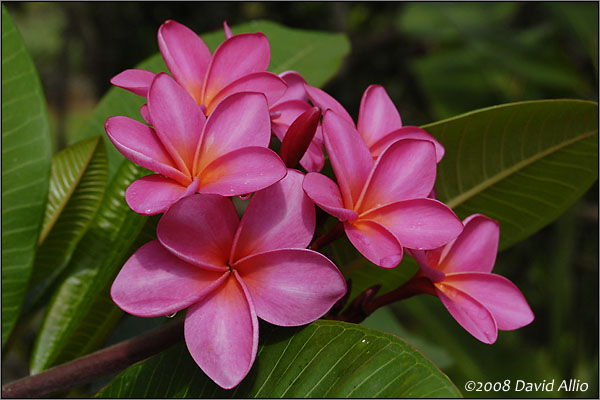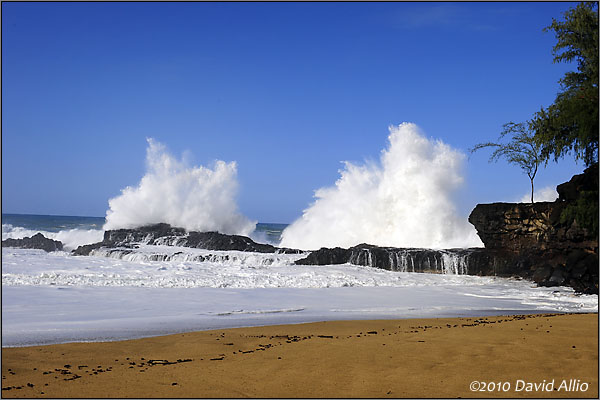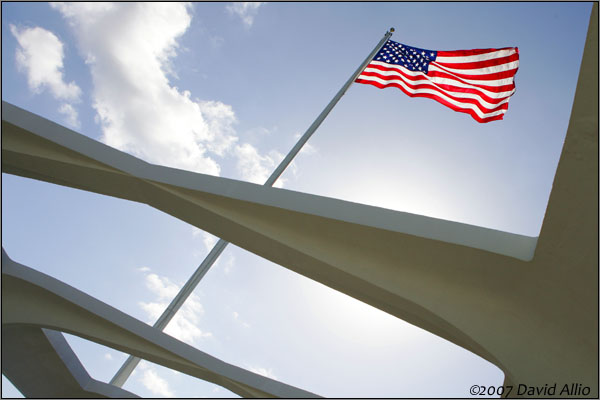Lawai Kauai Hawaii
One of the most popular features of my photographic workshops, presentations, and lectures are the open question-and-answer sessions. Usually the questions are technical in nature. However, during a recent presentation to a mainland photo association, the host posed a question about the significance of having a working knowledge of a photo subject.
Of course it is possible to create, and have published, a photograph purely on composition without an intimate knowledge of a subject. But, the more details the photographer can supply with the photograph the more likely an image is to be published.

Red Plumeria
Before moving to Kauai, I had very little experience with tropical flowers – especially Plumeria. My lack of knowledge of this colorful flower led to a potentially embarrassing situation before one of my early island photography workshops.
My presumptuous plan was to entice participants with a mid-winter photo workshop featuring tropical flowers. Lost in my enthusiasm and lack of local knowledge was the fact that these specific tropical plants are typically dormant for about four months, beginning in November. That means bare branches – no green leaves and no colorful flowers.
Fortunately, hibiscus and other plants were blooming and available as suitable subjects for that particular photo study. And I humbly learned to pay closer attention to the seasonal changes on The Garden Island.
A Nikon D40x camera equipped with an AF-S Nikkor 18-55mm G DX lens was used for this photograph. The focal length was 55mm with an aperture of f/8, shutter speed of 1/800th second, and film speed 400 ISO. Lighting was diffuse sunlight.
“Everybody is ignorant, only on different subjects.” – Will Rogers [1879–1935]
Kauai Hawaii
“Do you have a favorite place to take photographs?”
This time of year, a sunny winter day on Lumahai Beach on the North Shore of Kauai fulfills my need for variety, action, solitude, and beauty. When the North Shore is cloud-covered, the sky and ocean are an unappealing and dreary shade of gray. But when the sun shines, the golden sand, thundering surf, dark lava flow, and blue sky combine to create one of the most beautiful and invigorating places in the world.

Lumahai Beach | Kauai Hawaii
Unlike summer months when the wide beach is packed with locals and tourists, in winter it is possible to spend hours on Lumahai Beach without intrusion. Although both the air and water temperatures usually remain in the mid-70s throughout the year, when the shoreline begins to erode on the North Shore, there are more popular beaches for sunning and swimming on other parts of the Garden Island.
In summer months, Lumahai Beach is an idyllic wide strip of rejuvenated sand framed by an often glass-smooth Pacific Ocean. As the seasons change, the beach disappears. Waves increase in height. And, the ocean becomes more vigorous. Along the trail to the ocean’s edge there are officially posted warning signs, along with unofficial memorials and body count markers, that serve as testimony to the dangerous surroundings. From personal experience, these warning are valid. Even after studying the ocean, observing the water for over an hour, and seeking out the safest vantage point, a rogue wave surprisingly surrounded me in neck-deep water in an area that had previously been high, dry, and protected.
In addition to safety concerns, there are other challenges to any photographer attempting to present the constantly changing scene at Lumahai Beach, including the salty ocean spray carried onshore, onto you, and onto your camera equipment by the typical 20-knot mauka wind. Then, there is the creative challenge of proper exposure. The big white plumes of spray create quite a contrast as the wave impact the black lava. Which extreme, white spray or black lava, would your in-camera meter select for an automated exposure?
Kauai and the other Hawaiian Islands are dominated by scenic settings abundant with contrast. These scenes usually lead to errors in exposure based on biased in-camera meter readings.
For this exposure, the Nikon D3 camera equipped with an AF-S Nikkor 24-70mm 1:2.8G ED lens was set to Manual. For composition, the zoom lens was set at 34mm. And, the exposure data was f/8 at 1/1000th of a second with 200 ISO as the film speed setting. The f/8 aperture provided enough depth of field to allow the whole scene to be in focus, while a shutter speed of 1/1000th of a second captured the spray in mid-air. All three exposure settings were a creative choice based on my interpretation of the scene.
In actuality, the manual settings selected for this photograph created an under-exposure of one-third of one f/stop – an exposure option carried over from traditional slide film. The slight under-exposure enhances color saturation in sunlit landscape scenes without the use of post-production software.
Aloha!
Pearl Harbor, Honolulu, Hawaii
“December 7, 1941 – a date which will live in infamy – the United States of America was suddenly and deliberately attacked by naval and air forces of the Empire of Japan.”
– Franklin Delano Roosevelt – 32nd President of the United States –

USS Arizona Memorial at Pearl Harbor
An historic marker attached to the white memorial structure that sits across the remains of the sunken battleship reads, in part: “USS Arizona Memorial, War Memorial of the Pacific, Pearl Harbor, Hawaii, …In honor and in commemoration of the members of the armed forces of the United States who gave their lives to their country during the attack on Pearl Harbor, Hawaii, on December 7,1941. Public Law 87-201. Construction authorized by the 85th Congress. Appropriation granted by 87th Congress.”
At the bottom of the same marker, the losses of that day are noted: US Army – 228, US Navy – 2004, and US Marine Corps – 109. The noise and terror of the battle that day, 70 years ago, have been replaced by calm and homage embodied by the memorial.
This photograph of the flag of the United States of America flying in tropical blue skies over the USS Arizona Memorial was composed using a 24mm lens. Note that the morning sun was shielded by one of the open ceiling beams of the USS Arizona Memorial structure. The Manual Mode exposure settings were: f/8 with a shutter speed of 1/1000th of a second using a film speed of 200 ISO. According to the “f/16 rule,” that exposure calculation means even if this scene had been in bright, direct sunlight it would have been underexposed by one-third of one f/stop. The creative curiosity comes from the fact that this photograph is purely backlit.



You must be logged in to post a comment.